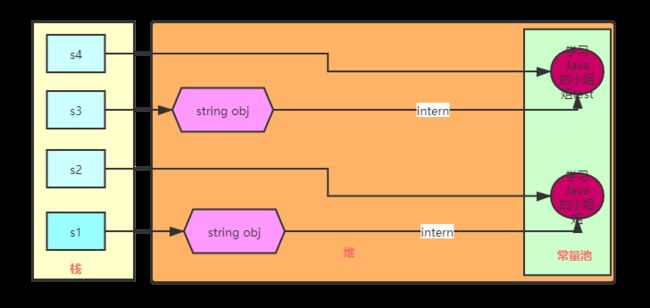1.String的特性
1.1不变性
我们常常听人说,HashMap 的 key 建议使用不可变类,比如说 String 这种不可变类。这里说不可变指的是类值一旦被初始化,就不能再被改变了,如果被修改,将会是新的类,我们写个demo 来演示一下。
public class test {
public static void main(String[] args){
String str="hello";
str=str+"world";
}
}
复制代码从代码上来看,s 的值好像被修改了,但从 debug 的日志来看,其实是 s 的内存地址已经被修了,也就说 s =“world” 这个看似简单的赋值,其实已经把 s 的引用指向了新的 String,debug 截图显示内存地址已经被修改,两张截图如下,我们可以看到标红的地址值已经修改了。
用示意图来表示堆内存,即见下图。
我们可以看下str的地址已经改了,说了生成了两个字符串,String类的官方注释为Strings are constant; their values cannot be changed after they are created. 简单翻译下为字符串是常量;它们的值在创建后不能更改。
下面为String的相关代码,如下代码,我们可以看到:
- String 被 final 修饰,说明 String 类绝不可能被继承了,也就是说任何对 String 的操作方法,都不会被继承覆写,即可保证双亲委派机制,保证基类的安全性。
- String 中保存数据的是一个 char 的数组 value。我们发现 value 也是被 final 修饰的,也就是说 value 一旦被赋值,内存地址是绝对无法修改的,而且 value 的权限是 private 的,外部绝对访问不到,String没有开放出可以对 value 进行赋值的方法,所以说 value 一旦产生,内存地址就根本无法被修改。
/** The value is used for character storage. */
private final char value[];
/** Cache the hash code for the string */
private int hash; // Default to 0
/** use serialVersionUID from JDK 1.0.2 for interoperability */
private static final long serialVersionUID = -6849794470754667710L;
复制代码1.2相等判断
相等判断逻辑写的很清楚明了,如果有人问如何判断两者是否相等时,我们可以从两者的底层结构出发,这样可以迅速想到一种贴合实际的思路和方法,就像 String 底层的数据结构是 char 的数组一样,判断相等时,就挨个比较 char 数组中的字符是否相等即可。
(这里先挖个坑,携程问过类似题目)
public boolean equals(Object anObject) {
//如果地址相等,则直接返回true
if (this == anObject) {
return true;
}
//如果为String字符串,则进行下面的逻辑判断
if (anObject instanceof String) {
//将对象转化为String
String anotherString = (String)anObject;
//获取当前值的长度
int n = value.length;
//先比较长度是否相等,如果长度不相等,这两个肯定不相等
if (n == anotherString.value.length) {
char v1[] = value;
char v2[] = anotherString.value;
int i = 0;
//while循环挨个比较每个char
while (n-- != 0) {
if (v1[i] != v2[i])
return false;
i++;
}
return true;
}
}
return false;
}
复制代码相等逻辑的流程图如下,我们可以看到整个流程还是很清楚的。
1.3替换操作
替换在平时工作中也经常使用,主要有 replace 替换所有字符、replaceAll 批量替换字符串、replaceFirst这三种场景。
下面写了一个 demo 演示一下三种场景:
public static void main(String[] args) {
String str = "hello word !!";
System.out.println("替换之前 :" + str);
str = str.replace('l', 'd');
System.out.println("替换所有字符 :" + str);
str = str.replaceAll("d", "l");
System.out.println("替换全部 :" + str);
str = str.replaceFirst("l", "");
System.out.println("替换第一个 l :" + str);
}
复制代码这边要注意一点是replace和replaceAll的区别,不是替换和替换所有的区别哦。
而是replaceAll支持正则表达式,因此会对参数进行解析(两个参数均是),如replaceAll("d", ""),而replace则不会,replace("d","")就是替换"d"的字符串,而不会解析为正则。
1.4 intern方法
String.intern() 是一个 Native 方法,即是c和c++与底层交互的代码,它的作用(在
JDK1.6和1.7操作不同
)是:
如果运行时常量池中已经包含一个等于此 String 对象内容的字符串,则直接返回常量池中该字符串的引用;
如果没有, 那么
在jdk1.6中,将此String对象添加到常量池中,然后返回这个String对象的引用(此时引用的串在常量池)。
在jdk1.7中,放入一个引用,指向堆中的String对象的地址,返回这个引用地址(此时引用的串在堆)。
/**
* Returns a canonical representation for the string object.
*
* A pool of strings, initially empty, is maintained privately by the
* class {@code String}.
*
* When the intern method is invoked, if the pool already contains a
* string equal to this {@code String} object as determined by
* the {@link #equals(Object)} method, then the string from the pool is
* returned. Otherwise, this {@code String} object is added to the
* pool and a reference to this {@code String} object is returned.
*
* It follows that for any two strings {@code s} and {@code t},
* {@code s.intern() == t.intern()} is {@code true}
* if and only if {@code s.equals(t)} is {@code true}.
*
* All literal strings and string-valued constant expressions are
* interned. String literals are defined in section 3.10.5 of the
* The Java™ Language Specification.
*
* @return a string that has the same contents as this string, but is
* guaranteed to be from a pool of unique strings.
*/
public native String intern();
复制代码
如果看上面看不懂,我们来看下一下具体的例子,并来分析下。
public static void main(String[] args) {
String s1 = new String("学习Java的小姐姐");
s1.intern();
String s2 = "学习Java的小姐姐";
System.out.println(s1 == s2);
String s3 = new String("学习Java的小姐姐") + new String("test");
s3.intern();
String s4 = "学习Java的小姐姐test";
System.out.println(s3 == s4);
}
复制代码我们来看下结果,实际的打印信息如下。
为什么显示这样的结果,我们来看下。所以在 jdk7 的版本中,字符串常量池已经从方法区移到正常的堆 区域了。
- 第一个false: 第一句代码String s1 = new String("学习Java的小姐姐");生成了2个对象。常量池中的“学习Java的小姐姐” 和堆中的字符串对象。
s1.intern();这一句是 s1 对象去常量池中寻找后,发现 “学习Java的小姐姐” 已经在常量池里了。接下来String s2 = "学习Java的小姐姐";这句代码是生成一个 s2的引用指向常量池中的“学习Java的小姐姐”对象。 结果就是 s 和 s2 的引用地址明显不同,所以为打印结果是false。 - 第二个true:先看 s3和s4字符串。
String s3 = new String("学习Java的小姐姐") + new String("test");,这句代码中现在生成了3个对象,是字符串常量池中的“学习Java的小姐姐” ,"test"和堆 中的 s3引用指向的对象。此时s3引用对象内容是”学习Java的小姐姐test”,但此时常量池中是没有 “学习Java的小姐姐test”对象的,接下来s3.intern();这一句代码,是将 s3中的“学习Java的小姐姐test”字符串放入 String 常量池中,因为此时常量池中不存在“学习Java的小姐姐test”字符串,常量池不需要再存储一份对象了,可以直接存储堆中的引用。这份引用指向 s3 引用的对象。 也就是说引用地址是相同的。最后String s4 = "学习Java的小姐姐test";这句代码中”学习Java的小姐姐test”是显示声明的,因此会直接去常量池中创建,创建的时候发现已经有这个对象了,此时也就是指向 s3 引用对象的一个引用。所以 s4 引用就指向和 s3 一样了。因此最后的比较s3 == s4是 true。
我们再看下,如果把上面的两行代码调整下位置,打印结果是不是不同。
public static void main(String[] args) {
String s1 = new String("学习Java的小姐姐");
String s2 = "学习Java的小姐姐";
s1.intern();
System.out.println(s1 == s2);
String s3 = new String("学习Java的小姐姐") + new String("test");
String s4 = "学习Java的小姐姐test";
s3.intern();
System.out.println(s3 == s4);
}
复制代码第一个false: s1 和 s2 代码中,s1.intern();,这一句往后放也不会有什么影响了,因为对象池中在执行第一句代码String s = new String("学习Java的小姐姐");的时候已经生成“学习Java的小姐姐”对象了。下边的s2声明都是直接从常量池中取地址引用的。 s 和 s2 的引用地址是不会相等的。
第二个false:与上面唯一的区别在于 s3.intern(); 的顺序是放在String s4 = "学习Java的小姐姐test";后了。这样,首先执行String s4 = "学习Java的小姐姐test";声明 s4 的时候常量池中是不存在“学习Java的小姐姐test”对象的,执行完毕后,“学习Java的小姐姐test“对象是 s4 声明产生的新对象。然后再执行s3.intern();时,常量池中“学习Java的小姐姐test”对象已经存在了,因此 s3 和 s4 的引用是不同的。
String、StringBuilder和StringBuffer
2.1 继承结构
-
2.2 主要区别
1)String是不可变字符序列,StringBuilder和StringBuffer是可变字符序列。
2)执行速度StringBuilder > StringBuffer > String。
3)StringBuilder是非线程安全的,StringBuffer是线程安全的。
参考: 《2020最新Java基础精讲视频教程和学习路线!》
链接:https://juejin.cn/post/694526...







